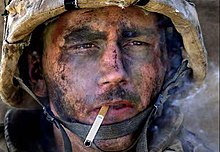James Blake Miller
James Blake Miller | |
|---|---|
| Birth name | James Blake Miller |
| Nickname(s) | Marlboro Man Marlboro Marine |
| Born | July 10, 1984 Jonancy, Kentucky |
| Allegiance | |
| Service/ | |
| Years of service | 2001–2005 |
| Unit | 8th Marine Regiment |
| Battles/wars | Iraq War |
James Blake Miller (born July 10, 1984) is a United States Marine Corps veteran of the Iraq War, who fought in the Second Battle of Fallujah and was dubbed the "Marlboro Man" (and the "Marlboro Marine") after an iconic photograph of him with a cigarette was published in newspapers in the United States in 2004.[1][2] Miller suffered from post-traumatic stress disorder after the war.[1]
Early life[edit]
Miller grew up in Jonancy, Kentucky.[1] Miller's parents' inspiration of his middle name was the show Dynasty, and both grandfathers served in the military with one serving in combat during the Vietnam War.[3] He became an ordained minister.[1] Not interested in working in the coal mines, Miller joined the United States Marine Corps, with the intention of eventually working in law enforcement.[1]
Iraq War[edit]
Second Battle of Fallujah[edit]
Miller was part of Charlie Company of the 1st Battalion, 8th Marine Regiment, a unit which took part in the Second Battle of Fallujah in November 2004. Los Angeles Times photographer Luis Sinco took a photo of 20-year-old Miller leaning against a wall, smoking a cigarette. In explaining the photograph, Sinco said that "His expression caught my eye. To me, it said: terrified, exhausted, and glad just to be alive. I recognized that look because that's how I felt too."[1]
Marlboro Marine[edit]

Sinco's photograph of Miller was published in many newspapers. CBS Evening News anchor Dan Rather singled out the photo for its excellence, and turned the then-unidentified Marine into a celebrity. Sinco was told to find the Marine for a follow-up story and tracked down Miller four days later in an auditorium near Fallujah's civic center. Miller was embarrassed about the photo's fame, but shared information with Sinco. The two would remain friends thereafter.[1]
After his identity was made public, people sent him care packages, including many cigarettes; President George W. Bush sent cigars, candy and memorabilia from the White House. The forward command center soon featured a large blowup of the photo. The Commanding General of the 1st Marine Division, Richard F. Natonski, made a special trip to see Miller, to Miller's surprise. The general shook Miller's hand and let him know that, because Americans had "connected" with his photo, and nobody wanted to see him wounded or dead, he was offered a trip home. Miller turned down the offer because he did not want to leave his comrades behind.[1]
The photo was a finalist for the Pulitzer Prize for Feature Photography in 2005.[4] The photograph was nominated by Slate in 2011 for a list of "New Classics", products of the culture since 2000 that will withstand the test of time.[5]
Post-war[edit]
After his tour, Miller returned to Marine Corps Base Camp Lejeune in North Carolina.[1] He was married in June 2005.[6] Divorce papers were filed a year later.[7] He was deployed aboard the USS Iwo Jima, to assist recovery efforts following Hurricane Katrina. During that period he blacked out during a PTSD episode.[4] In November 2005, Miller was medically discharged from the Marine Corps.[1]
In 2008, Miller was living in his hometown and having difficulty receiving care from the United States Department of Veterans Affairs.[4] By 2013, he had reunited with his wife and, with the help of Sinco, has sought psychological help.[8]
References[edit]
- ^ a b c d e f g h i j Luis Sinco, Two lives blurred together by a photo, Los Angeles Times, November 11, 2007.
- ^ John Pettegrew (28 October 2015). Light It Up: The Marine Eye for Battle in the War for Iraq. JHU Press. pp. 170–172. ISBN 978-1-4214-1786-8.
Regina Lee Blaszczyk (3 October 2011). Producing Fashion: Commerce, Culture, and Consumers. University of Pennsylvania Press. p. 187. ISBN 978-0-8122-0605-0.
Guy Westwell (21 October 2014). Parallel Lines: Post-9/11 American Cinema. Wallflower Press. p. 158. ISBN 978-0-231-17203-5. - ^ Stannard, Matthew B. (29 January 2006). "The War Within". San Francisco Chronicle. Retrieved 1 December 2016.
- ^ a b c Eliscu, Jenny (3 April 2008). "The Troubled Homecoming of the Marlboro Marine". Rolling Stone. Retrieved 29 March 2017.
- ^ Heather Murphy (2011-11-06). "The New Classics". Slate. Retrieved 2011-11-07.
- ^ Luis Sinco, Rescue operation aims to save a wounded warrior, Los Angeles Times, November 12, 2007.
- ^ 'Marlboro Man' Divorcing Wife After Dream Wedding[dead link], Los Angeles Times, June 27, 2006.
- ^ "Marine haunted by Fallujah". CNN. 18 March 2013. Retrieved 29 March 2017.
External links[edit]
- "Marine Whose Photo Lit Up Imaginations Keeps His Cool"
- Luis Sinco, Chad A. Stevens, Mary Cooney, Alan Hagman, James Blake Miller (16 November 2007). The Marlboro Marine.
